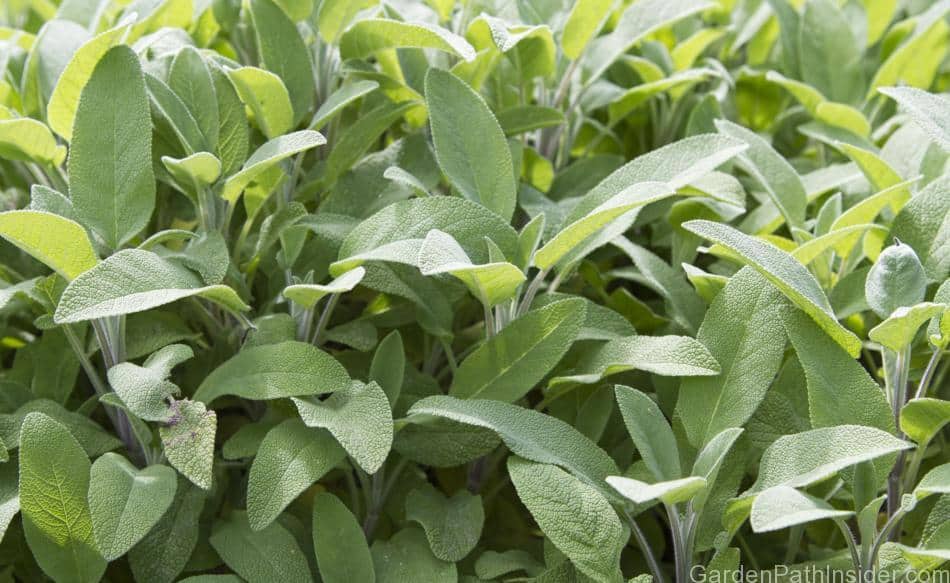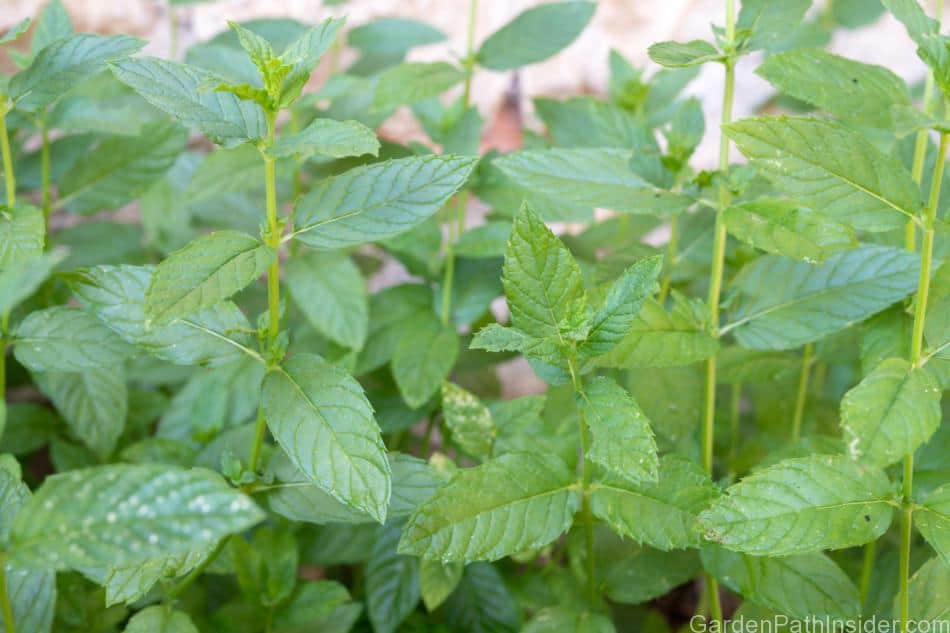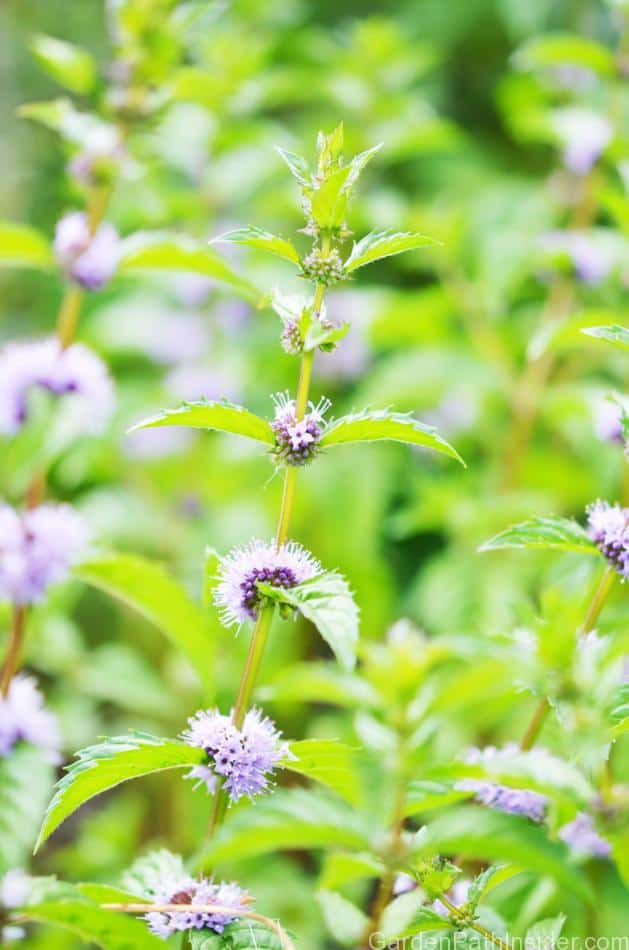
Mint and sage are fragrant flavorful herbs that are used in many culinary dishes and refreshing beverages. These herbs are easy to grow and make a great addition to any herb garden.
Mint and sage should not be planted together in the same container as mint and sage have different soil and water requirements. Mint is also an invasive species and can quickly overtake a growing space. Mint and sage are great companion plants to grow next to each other in separate containers as both culinary herbs have the same light and temperature needs.
Mint and sage are easy herbs to plant and take care of indoors or outside. Once planted, there is little maintenance required for these herbs. Both will provide an abundance of flavorful leaves throughout the season, year after year.
Overview of Mint

Mint is a fast-growing perennial herb, that is grown and cultivated for its flavorful edible leaves. Mint leaves are used in many culinary meals, beverages, and treats.
The flavor and fragrance of mint vary by its variety, from sweet mints and peppermint flavors to unique flavors like apple mint, pineapple mint, and chocolate mint.
Mint requires moist fertile well-draining soil and full sun of 6 to 8 hours per day. Some varieties of mint grow up to 36 inches tall (91cm), while most stay at or below 18 inches (45cm).
Mint is an invasive species and spreads in its growing space very quickly during the growing season. Mint grows down in the soil only about 8 inches (20cm); though its runner roots called rhizomes, grow horizontally outward from the plant continuously during the growing season.
If mint is grown in a garden bed, the bed should be surrounded by a garden bed barrier to prevent the mint roots from growing beyond their designated border.
A garden bed barrier is similar to plastic edging barriers and is planted below the surface of the soil in a perimeter around the mint patch. As the mint roots do not grow very deep, the garden bed barrier does not need to be planted more than 8 inches deep (20cm).
Left unchecked, the mint patch can take over your garden and return each year until fully and properly eradicated.
Overview of Sage
Sage is a fragrant flavorful herb used in savory culinary dishes and often used to flavor pork, turkey, and chicken dishes. The leaves of the sage plant are harvested and used to cook with.
Sage leaves are very potent and only a small amount of sage is needed when cooking a meal; to preserve sage, the leaves are dried after harvest and stored in glass mason jars once fully dried.
Sage is native to the Mediterranean and thrives in drier neutral soil. Sage can tolerate drought conditions and does well when watered less frequently. When sage is watered sparingly the leaves maintain a stronger flavor and fragrance.
Less water will develop a more distinct and concentrated flavor in the sage leaves. If sage is frequently watered or overwatered the flavor of the herb will be diluted.
Sage is a perennial and will return each year, though the life of a sage plant is only about four to six years. The summer of the fourth year is a great time to take cuttings and begin to propagate the next generation of your sage garden.
Container & Growing Space Requirements
Mint is an invasive herb and will quickly spread and fill any size container it is planted in. The width of the container can be as large as your growing space will allow, while the depths of the container needs to be at least 8 inches deep (20cm).
Mint grown in a garden bed should be planted in a raised garden bed or planted within a perimeter garden bed barrier. A garden bed barrier is planted in the ground around the mint patch to prevent its roots from spreading and overtaking the garden.

Sage thrives in drier conditions and neutral soil. Due to the need for a drier environment, sage thrives in raised garden beds and potted in containers. The raised beds and containers make it easier to control the water intake and drainage of the sage plant.
When potting sage in a container, use a container that is significantly larger than the root ball. A pot about 6 inches (15cm) larger in diameter than the root ball will provide extra soil to help absorb any excess water in the sage plant’s root system.
Soil Needs for Mint and Sage
Mint thrives in moist fertile soil, though it can also grow in rocky topsoil. Mint grown for culinary use should be planted in nutrient-rich soil or vegetable specific potting soil mixes.
Vegetable and herb specific potting mixes are great if you are growing mint in container gardens or raised beds. If you are planting a mint patch in your yard, little more is needed than light organic fertilizer once per season.
Sage thrives in rocky gritty soils, similar to the growing conditions of sage’s native Mediterranean soil. The rocky soil helps excess water drain from the plant’s roots and avoid overwatering. With the rocky soil, I add organic compost to a 1:1 ratio. This mix will provide nutrient-rich well-draining rocky soil for the sage plant to grow and thrive.
Sage and mint can thrive in the same type of growing conditions and soils. The main reason these herbs should be grown separately is the level of water they need to grow. We will cover watering needs in the section below.
Water Needs for Mint and Sage
Mint Water Needs
Mint requires moist soil and daily watering in warm spring and summer months. A mint patch will grow and spread continuously during the growing season, often requiring watering twice per day in hotter summer months.
Water in the early morning or at dusk, both points when the sun is lowest in the sky. This will prevent the water from evaporating before the plants can absorb it.
Watering potted mint: Potted mint is very susceptible to overwatering. Before watering the mint daily check for the signs of dehydration.
1: Dry Soil: Touch the soil with your fingertips to measure the soil moisture. If you have a larger garden, a soil moisture meter will take more accurate measurements of the soil moisture. For potted plants, also look to the perimeter of the soil for hydration status.
When the soil in a pot is getting extremely dry the soil will pull away from the side of the pot. Though with mint you will see the signs of dehydration in the leaves and stems before the soil starts to pull away from the sides of the pot.
2: Wilted leaves: Wilted leaves could mean the plant is dehydrated, or the plant is overwatered. It is difficult to tell dehydration from the leaves alone, so this is an overall health check that can alert you to a problem with the plant’s health.
3. Drooping stems: When mint needs water the tips of the branches with new growth will begin to droop. The new growth will show signs of dehydration before other parts of the mint stems, as the stems tend to get thicker and woodier as the plant matures.
Sage Water Needs
Sage thrives in drier soil and does best with a thorough watering every few days as needed. Between thorough watering’s it is best to let the soil stay on the drier side. Sage can withstand droughts well in summer months, though watering frequently will provide more consistent growth.
Potted sage grown in container gardens is a great way to cultivate sage. In a pot, you can control the water, temperature, and sunlight far better than in the ground. Raised beds are a great idea if you have space and materials, and in the winter the raised beds can be covered with a tarp to better insulate against the cold.

Growing sage in the ground in warmer climates is a great addition to any garden bed, as sage spreads very slowly and is easily contained, unlike the invasive mint plants. Sage grown in colder climates may need to be replanted every year as it may not survive the cold winters.
Light Needs for Mint and Sage
Both mint and sage require full sun of 6 to 8 hours per day to thrive, though both plants can grow in partial sun if that is what is available. Herbs grown indoors should be placed by a window that gets full sun. Be careful to keep indoor plants away from space heaters, stoves, ovens, and any other direct heat source.
Harvest Time for Mint and Sage
The leaves of the mint plant are edible and can be harvested anytime during the growing season. For the overall health of the plant, wait for the roots to establish and the mint to start producing new growth before harvesting leaves.
To harvest mint, cut the leaves off the stem and rinse off before eating. Extra leaves can be stored in paper towel and placed in the refrigerator. Use a sharp pair of scissors when harvesting herbs to prevent the stem from being damaged during harvest.
If a mint stem breaks off the plant during harvest, you can take the stem and place it in a cup of water to preserve the leaves for use later. The mint leaves will stay vibrant for several days.
The leaves and flowers of culinary sage are edible and can be harvested throughout the season.
To harvest sage, use a sharp pair of scissors to cut the leaves off the plant. Lay the leaves out in a bowl or container without a lid or cover and the leaves will dry in a few days.
Another method to dry sage leaves is to place the leaves in a paper bag for a day or two after the leaves have been air-dried.
When the leaves are dry, they will become very brittle and crumble easily. Once the leaves are completely dry, place in a glass jar for long term storage.
Summary Chart for Mint and Sage
| Plant | Soil type | Water needs | Light needs | Bloom time | Harvest time |
| Mint | Loose well-draining fertile soil | Keep the soil slightly damp to moist. Water as needed. | Full sun (6 to 8 hours per day) | Spring/Summer | Mint leaves are edible at any time, though best practice Is to wait until the plant gets at least 6 inches tall (15cm) before harvesting. |
| Sage | Drier gritty soil | Less is more when watering sage. Keep the soil on the drier side, checking moisture levels daily in warmer climates. | Full sun (6 to 8 hours per day) | Spring/Summer | Sage leaves can be harvested at any time, though the flavor is best before the flowers bloom. |
Cover image: Sage plant growing in an herb garden_© Stephen Cordory/123rf.com
